There’s a traditional narrative that Brazil's carnaval is a moment of social inversion which functions as a release valve for class tensions. For a few days per year, as the story goes, rich people dress like poor, poor people dress like kings and queens, men dress like women and women dress like men. Christianity is subordinated to Afro-Brazilian religions and everything goes back to normal on Ash Wednesday when we are reminded that we will all return to dust.
It's a nice story and, although there may be a few elements of symbolic truth to it, the fact is that since the earliest days of carnaval in Brazil, elites have worked to superimpose the existing class structure over it. For example, records show that as soon as large street parades cropped up in cities like Recife and Olinda during the 1870s, the rich started parading in horse carriages while the poor would go on foot. In the early 20th Century horses were replaced by cars.
Dictatorship periods were marked by repression of street carnaval and the establishment of huge private costume balls for the middle and upper classes which live on to this day. As street carnavals began to re-surge as a symbol of democratic opening in the waning days of the most recent military dictatorship (1964-1985) in cities like Salvador, Rio and Recife/Olinda, elites moved quickly to create expensive, safe spaces for their traditionally pampered middle-class youth.
In 1984, Rio de Janeiro's annual carnaval parade was moved into a stadium with admission prices out of reach for the average participant in the Escolas de Samba (traditionally based in favelas), that paraded through it, and even more expensive skyboxes for the rich and famous.
Salvador, a city rich in folklore and history but with no specific carnaval music of its own, revolutionized street carnaval in the 1950s with the invention of the trio elétrico, which exploded in popularity in the 1970s and is now used all over the country. Trios, as they are known for short, are semi-trucks that pull trailers full of speakers with stages built on top of them, which move through carnaval streets at around 2 miles an hour surrounded by groups of drunken revelers that can number into the tens of thousands.
Trio elétrico featuring São Paulo pop singer Gloria Groove makes it’s way up Salvador’s seaside on Feb. 12, 2024
Carnaval in Salvador, and dozens of other cities around Brazil that have copied it, can have miles of streets full of trios at any given moment, almost entirely featuring pop bands that don't play any special kind of carnaval music. It's something that would be both impossible and silly to try to confine to a stadium. How then, could Salvador's elites protect their youth from interacting with poor people? The solution was the most nefarious contribution to modern carnaval ever made: the abadá. An abadá is a t-shirt that gives its wearers access to a roped-off area behind a trio protected by police, armed security guards and dozen's of low-paid, mostly black and teenage rope holders.
Group of drunken, identically-clad elites sandwiched between military police and yellow-hat security personnel so they don’t have to interact with poor people in Salvador on Feb. 12, 2024
Street carnavals have long traditions of people wearing both female and male drag and making their own, hilarious and satirical costumes. The abadá replaces this explosion of creativity with groups of thousands of mainly white people wearing identical T-shirts. This year, the most expensive abadá in Salvador's carnaval, for the Camaleão trio, cost the equivalent of three times Brazil’s monthly minimum wage of R$1412, which is earned by roughly 60% of the national labor force.
“I paid R$4000 for this shirt!”
As trio mania spread across Brazil during the 1990s, citizens of the sister cites of Recife and Olinda, Pernambuco, which have a metro population of 3.7 million and are home to some of the oldest carnaval traditions, fought back and successfully pressured their city governments to outlaw sale of abadás and privatization of public space around carnaval blocos and trio elétricos. Recife/Olinda’s status as Brazil’s largest carnaval without a samba stadium or abadás was the deciding factor in choosing to film my coverage for TeleSur in Pernambuco this year. This is how it went down.
The Lumberjack Club
Frevo is a genre of carnaval music that emerged in Pernambuco during the late 19th Century, with a founding date often cited as 1907, the year the Clube Lenhadores, or Lumberjack Club was founded in Paudalho, Pernambuco. Like Choro in Rio de Janeiro, Frevo was created by laying afro-Brazilian dance rhythms under melodies from the polkas that were brought from Europe by Roma immigrants. Choro features guitars, mandolins and saxophones and first became popular in bars in Rio neighborhoods like Lapa. Frevo features tubas, trombones, trumpets and was made for musicians to play as they walk down the streets accompanying carnaval blocos.
In early days of the first wave of big street carnavals (from around 1870 to the outset of WW1), huge fistfights would often break out when two blocos ran into each other as they danced down the streets. This caused the grand Frevo clubs like Lenhadores to hire groups of capoeira fighters to lead the parades for security. The Police clamped down on carnaval groups for inciting violence and this led to the birth of Frevo dance. The capoiera fighters put on glittered costumes and replaced their clubs with umbrellas that were heavy enough to use as weapons if needed and, to fool the police, began dancing. Over the years, the dance evolved. Today, Frevo has over 100 different steps. The umbrellas have shrunk and are used as dance props to remind everyone of their history.
Paudaulho is the first town located outside the northern border of greater Recife in the sugar cane production region that provided 20% of Latin America’s GDP during the 1600s. Once connected to Recife by train, it's now a sleepy town of around 60,000 which comes alive every year during carnaval. There, among dozens of blocos and free concerts with national acts, the oldest frevo club rivalry plays out, between Lenhadores, founded in 1907, and Estrela, founded in 1915.
I arrived in front of Lenhadores headquarters on February 7 for its last rehearsal before carnaval. As "Gossip Square" filled with revelers wearing the traditional colors of red and black, they removed the club's official banner from a house where a family had been guarding it for the last year. They then held a brief ceremony remembering three club members who had died in 2023, and awarded plaques to the directors of two other famous carnaval organizations, Pitombeira de Cuatro Cantos frevo club and Galo da Madrugada carnaval bloco, whose official banners were raised along with that of the Lenhadores and carried for the duration of the parade. A Chevrolet Veraneio pushed its way through the crowd, decorated with colorful neon lights and covered with speakers. The parade leader climbed up a ladder to a platform on top and, as the tubas and percussion started up, led a crowd of thousands of people of all ages singing Lenhadores’ 117 year-old hymn.
"With hatchets in hand, to get the job done. Watching the young ladies accompany us to our club is what makes us happy
Look, at our banner, gentlemen. We are Lumberjacks and we live through art.
We are the Lumberjacks who have come out to parade. And this afternoon we have returned, with saudade for this beautiful carnaval
Look, at our banner, gentlemen. We are Lumberjacks and we live through art."
A group of teenage frevo dancers, tiny umbrellas in hand, lined up in front of the sound car and we were off, up and down the streets of downtown Paudalho. For the next 3 hours I didn't see a single fight and there was a minimal police presence. In short, I was lucky to be in the middle of a real carnaval parade, made up of primarily working class Afro-Brazilians of all ages, playing traditional carnaval music, with no violence.
See my TeleSur news story on Clube Lenhadores de Paudalho here:
The Rooster of Dawn
Since the explosion of Brazil's large street carnavals in the 1800s, there have been periods of growth and repression, when governments worked to criminalize blocos, banning them from parading in public and even arresting musicians for walking down the street with percussion instruments. The last period of repression took place during the US-backed military dictatorship of 1964-1985, forcing a large part of carnaval back indoors.
As support for the dictatorship collapsed and society began to reopen in the late 1970s, revelers returned to the streets with a vengeance, founding hundreds of new blocos like Recife's Galo da Madrugada, or Rooster of Dawn. Founded in 1978 by opponents of the military regime, the Galo, as it is known, was featured in the 1994 Guinness Book of World Records for largest carnaval parade in history when it drew a crowd of 1.5 million people. Since then, the Recife Mayor's Office has claimed crowds of up to 2.7 million but these numbers have been contested. After all, the greater Recife area has a population of 3.7 million and get's around 800,000 (mostly Brazilian) tourists during carnaval. Could it really be that over half of the city goes to the Galo?
Knowing that it can get crazy as the day goes on, I arrived early, already sweating in the muggy heat at 7:30 AM. Two hours before the official start there were already thousands of people on the 5 km route that the Galo's floats and trios would take. The crowd kept growing, and by the time I tried to get out of there at 11 AM, it was complicated. I had to push my way through the crowd but made it out with my camera equipment, smartphone and money intact. Unfortunately my friend Denet Pereira, a squat coordinator of the MTST/UNMP housing movement, wasn’t so lucky. He was brutally attacked by thieves , kicked and superficially stabbed in the head in front of a group of military police who refused to lift a finger. He's OK now, but the incident makes me wonder if Pernambuco Governor Raquel Lyra gave orders for police to only protect middle class revelers.
This brings me back to the issue of how elites superimpose the class system into carnaval. It may be illegal to charge for abadás in Recife but the bourgeois has found a work-around by renting out hundreds of storefronts, warehouses, spaces under viaducts and rooftops along the parade route. They are converted into exclusive boxes and clubs protected by private security forces and accessible by people wearing identical abadá-style T-shirts. Many of these spaces seemed to be hot, unsafe and overcrowded and appeared to lack emergency exists and fire safety equipment.
I left the Rooster of Dawn, inspired by my brief meeting with Bloco founder Mestre Zacarias and impressed with the size of the event, but disappointed by its commercialization. Furthermore, a few of my indicators of what makes a carnaval bloco great were missing. First of all, although there were some, the proportion of children and elderly people was lower than normal for a top level carnaval bloco. I understand that this is mainly due to safety concerns. During my 2 years living back up here in Recife, I have been constantly warned against taking my kid to the Galo by people from all class backgrounds. The second issue is the weather. Recife has always been so muggy that 85 feels like 95, but with a heat wave sending temperatures up into the mid 90s it was already extremely uncomfortable by 10 AM. The name of the bloco is the Rooster of Dawn, so why don't they start it at dawn? Another option would be starting it in mid-afternoon after the heat of the day has passed. With the only water down the parade route being sold at above market prices, one can only imagine that hundreds of thousands of poor people who danced down the shade-less avenues prioritized alcoholic beverages. The City hasn't released heat stroke figures yet, but I'm sure it was an issue.
See my Story on the Galo da Madrugada here:
Maracatu de Leão Faceiro
Maracatu de Baque Solto is one of two primary forms of Brazil's oldest carnaval music, Maracatu, which first appears in written archives in Pernambuco in 1711, with bands that were founded by slaves in the early 1800s still playing in carnaval to this day. One Maracatu genre, Maracatu de Baque Virado, is a traditional staple of carnaval in Olinda. The other primary genre, Maracatu de Baque Solto, comes from the heart of the sugar cane plantations and Atlantic rainforest outside of Recife known as the Northern Forest Zone.
After a drive down a dirt road through a military reserve which contains the largest remnant of old-growth Atlantic rainforest north of Bahia, I arrived on the morning of carnaval Sunday in Araçoiaba, which is one of the centers of Maracatu de Baque Solto. Today was the day in which over 20 local groups would go through a series of rituals, present themselves publicly and head off on buses for 3 days of performances in carnaval street parties across the state. A man named Cristiano - a friend of a friend -who was a Caboclo de Lanca, introduced me to some cousins and aunts and we sat around drinking coffee as he got his outfit together.
Cristiano
"My husband was a caboclo," an old woman said. "he scared me to death. Back in those days the spears had sharp points and they would fight. He used to carry a pouch at the belt of his costume with a revolver in it. When he was enchanted, he’d jump out of our window backwards.”
Cristiano give me a quick interview before putting on his headdress and, 30 minutes later, reappeared with a white carnation in his mouth to protect against spiritual attacks, joined a group Caboclo's de Lanca and they started dancing down the street to the tintinnabulation of the bells that were built into their costumes. I followed along as people came out of their houses and gave them money, and as they stopped in the back yard of a house where a large spread of alcoholic drinks, fruit and feijoada was laid out for them. As they took off the top half of their costumes and started drinking, I had a cup of Pitu and a piece of melon. One of the Caboclos struck up a conversation with me, "I can't tolerate people who aren't humble," he said, "we all go to the same place when we die, so what is the point of acting like you are better than anyone?"
It got really hot out and I decided to take a break. Back at Cristiano's aunt's house, I learned that that morning all of the Caboclos had gone through a shamanistic religious ritual and were "enchanted". In other words, I had been drinking cachaça with people who were possessed by spirits.
See my story on Maracatu de Leao Faceiro here.
Olinda and The Meeting of the Giant Puppets
Founded on a hill by the Portuguese in 1535, the historic center of Olinda is a UNESCO World Heritage site and home to what many people consider to be Brazil's greatest street carnaval. One of the birthplaces of both Frevo and Maracatu Nação, for the last 100 years Olinda's carnaval has been marked by giant puppets that dance their way through huge crowds of revelers, normally accompanied by a frevo orchestra and dancers.
The most famous of these puppets is the Homen da Meia Noite or Midnight Man, a 15-foot high, elegantly dressed man in white and green with a gold tooth. Every year, before the outset of carnaval, Midnight Man goes through a series of rituals transforming him into a Calunga, a type of Candomble spirit, and during carnaval he is treated as a living being by the crowd. Every year since 1932, Midnight Man has come out of his headquarters building, where he is stored during the rest of the year, on Friday at the stroke of midnight. As revelers launch fireworks, he slowly makes his way down the street, followed by hundreds of thousands of revelers, stopping in front of different houses to symbolically greet the residents. This event marks the beginning of carnaval.
For logistical reasons I had to choose between covering the Rooster of Dawn and Midnight Man for TeleSur this year, and opted for the former, due to the fact that it is easier for me to film in daylight and that getting an early start for the Rooster would guarantee a certain level of personal safety that would not be available to me at midnight on the first night of carnaval in Olinda.
It was a tough choice, as the mere mention of the Rooster or Midnight Man is enough to bring tears to the eyes of a lot of people in Pernambuco. I had to film something in Olinda though, so I decided to film the annual meeting of the giant puppets.
I arrived at Our Lady of Guadalupe Church at 8 AM on Fat Tuesday, to a scene of about 50 people standing around. Over the next three hours, it would gradually fill up, as more and more puppets arrived and their operators lined them up in a row in the center of the square. I took advantage of the quiet to film my stand up to camera early. All that was left now was for me to film some b-roll of the parade, which was simple enough that drinking a few beers wouldn't cause any problems. While talking to one of the beer vendors, a local resident who had set a stand up in front of his house, I learned that Midnight Man was not only coming, but that he was going to lead the parade. I walked up the route - a narrow street lined by small houses and beer and shish-ka-bob stands - and found a place to get out of the now-unbearable heat.
Eventually a crowd came around the corner and pushed by. Then I saw a group of teenage frevo dancers and behind them, the Midnight Man.
Frevo dancers clear the way for the Midnight Man
The second he appeared, a huge cheer echoed down the street. People threw confetti and he was bathed in love and adulation from the singing crowd. Somewhere between the burning sun, the frevo, the beer and this giant puppet with "Brasil is Indigenous Land" written on its back, I was charmed by Midnight Man. I rushed into the middle of the dancers and filmed as much as I could without interfering with anything, before a security officer ordered me to move on. I made my way forward a few hundred meters and ducked down a side street, positioning myself at an outdoor bar table where I could film another angle of Midnight Man going by with my lens zoomed out. The only other customers were a couple of bored and hungover looking hipsters at the next table.
"Midnight Man is coming," I said.
"No he isn't," the young man answered, "that's just Friday."
"He's coming. I was just up there filming him. He'll be here in 2 minutes."
"Wait.... You just saw him?" His face lit up, they immediately abandoned their drinks and ran up into the crowd.
The drum beats got louder and the cacophony grew into a single chant. "Here comes the Midnight Man, strolling through the streets. His costume is green and white to liven up the carnaval!"
Midnight Man came into view, showered in confetti, bowed to a family sitting on their second floor balcony, spun around and headed on, as dozens of giant puppets and thousands of revelers of all ages and social classes followed, in an example of what makes carnaval so great.


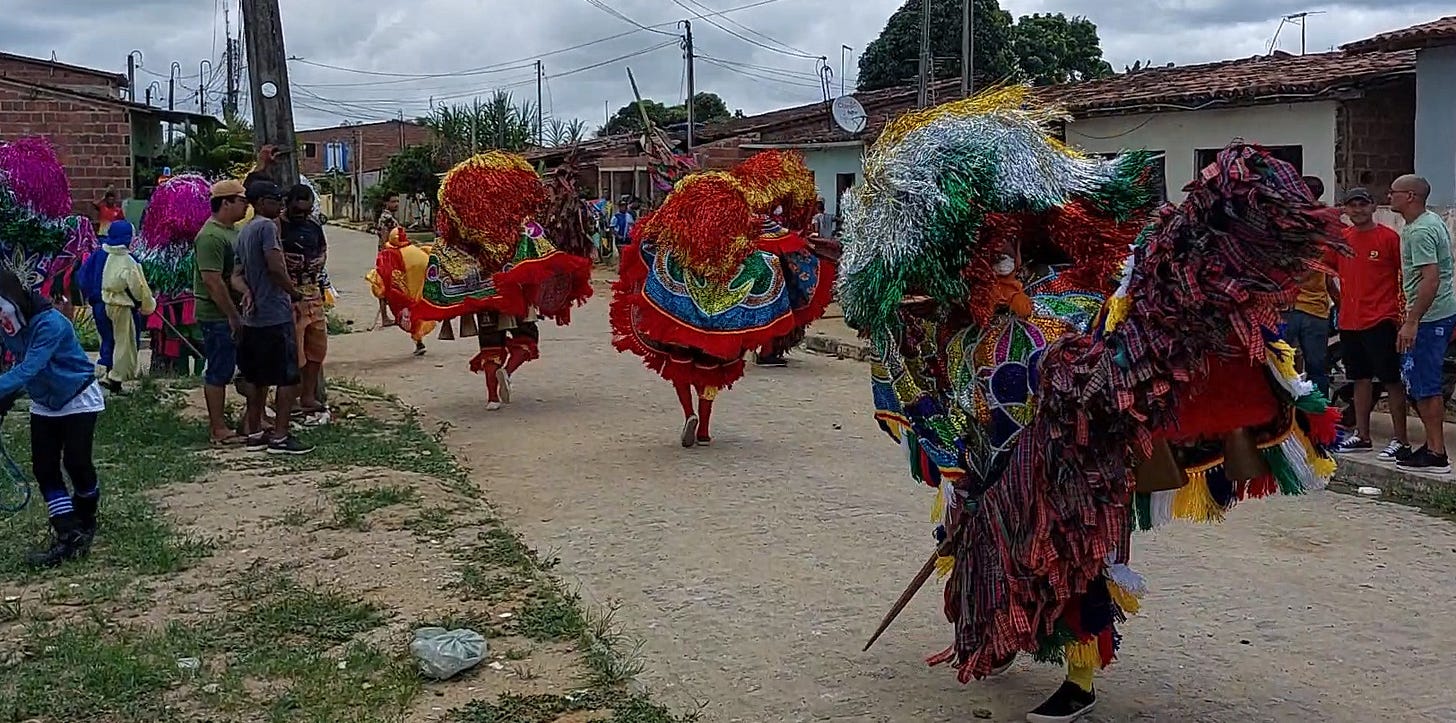
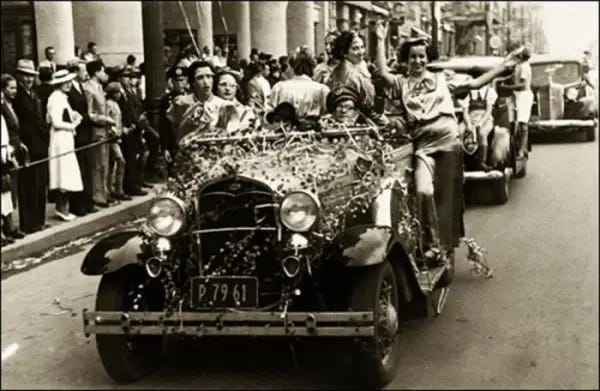
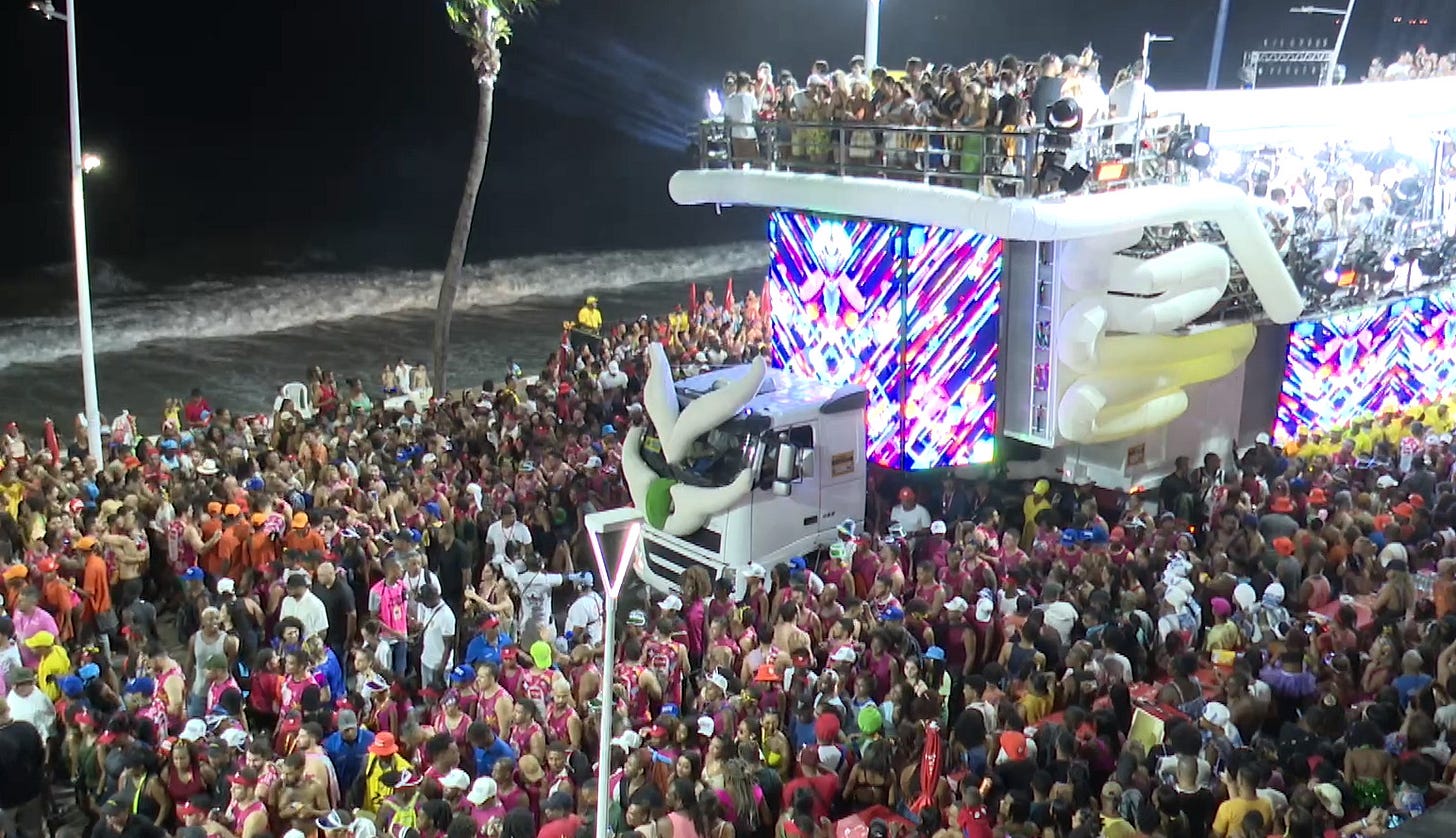
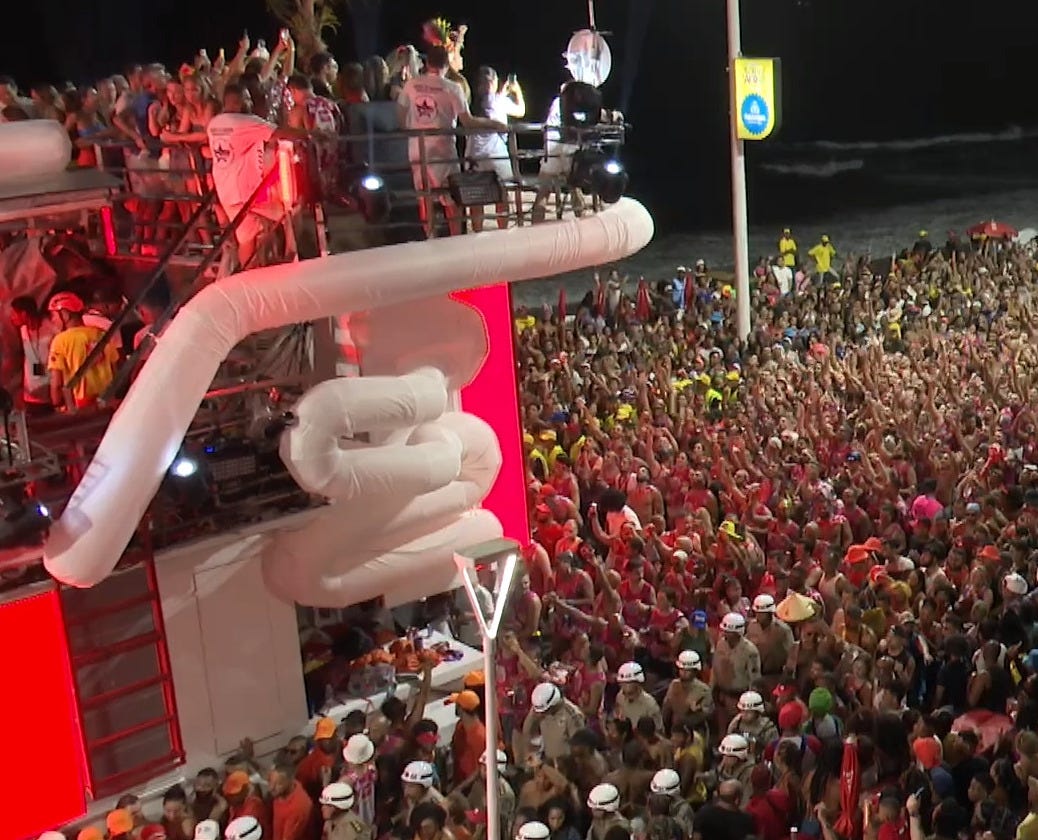

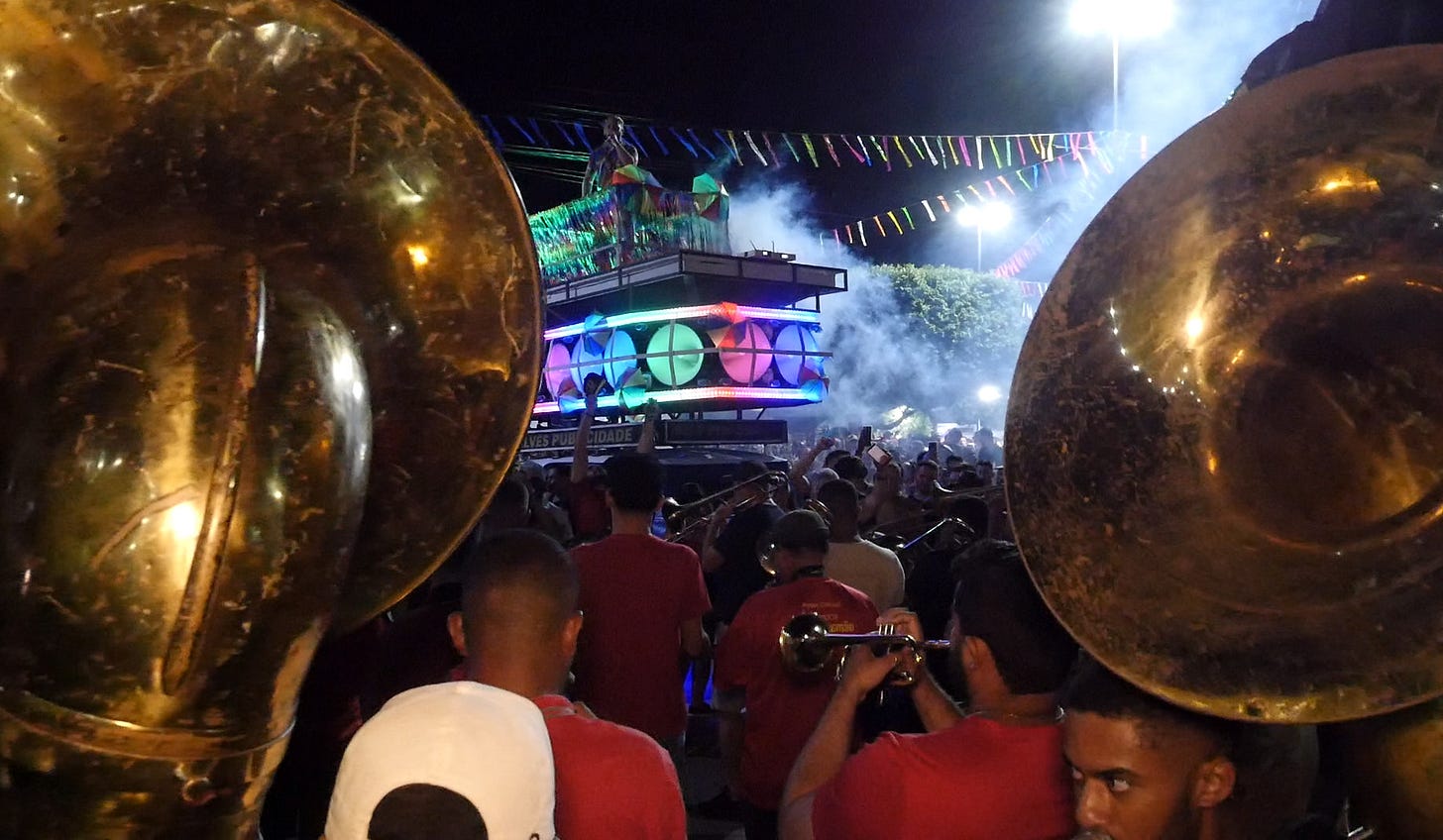
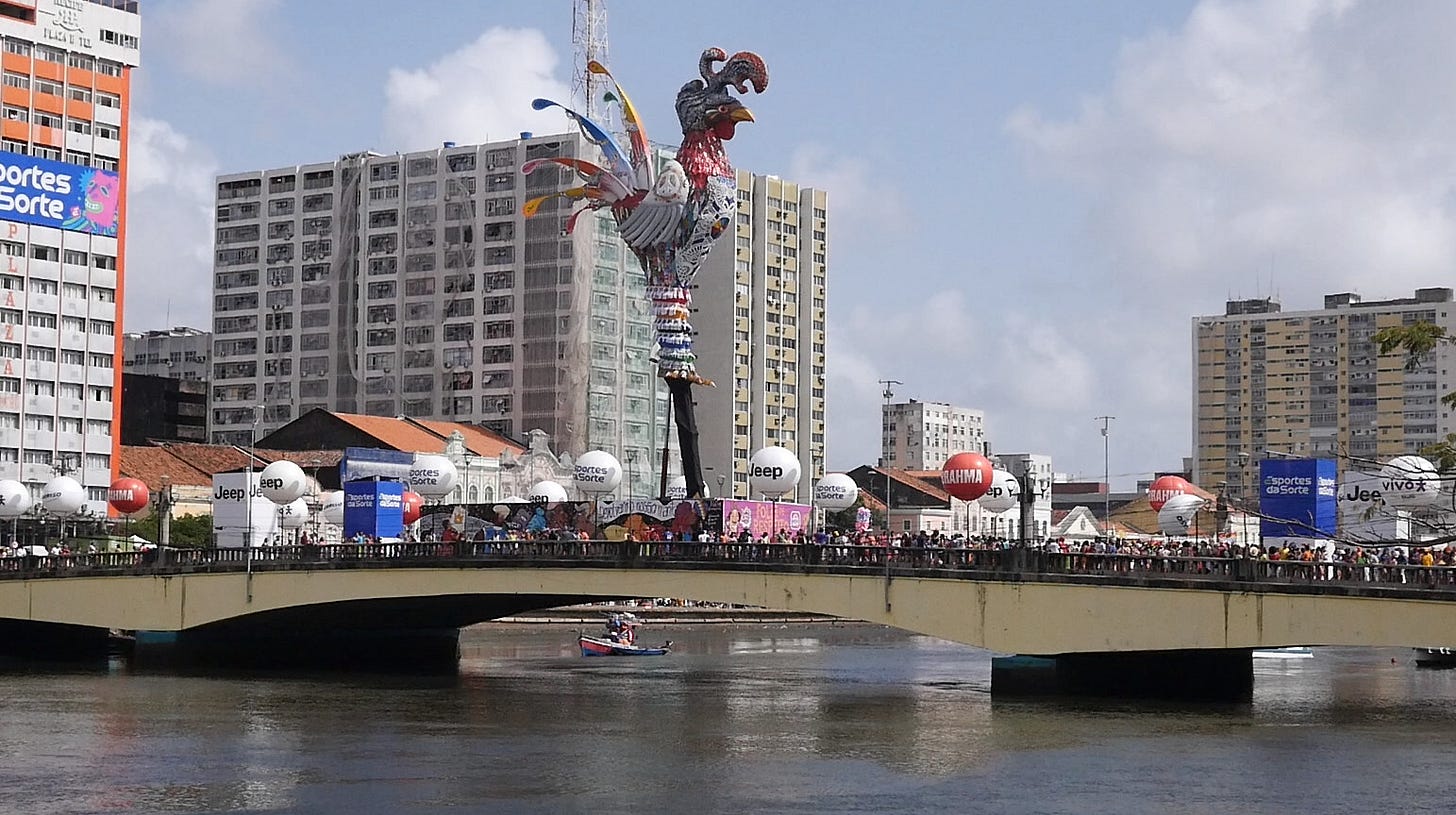
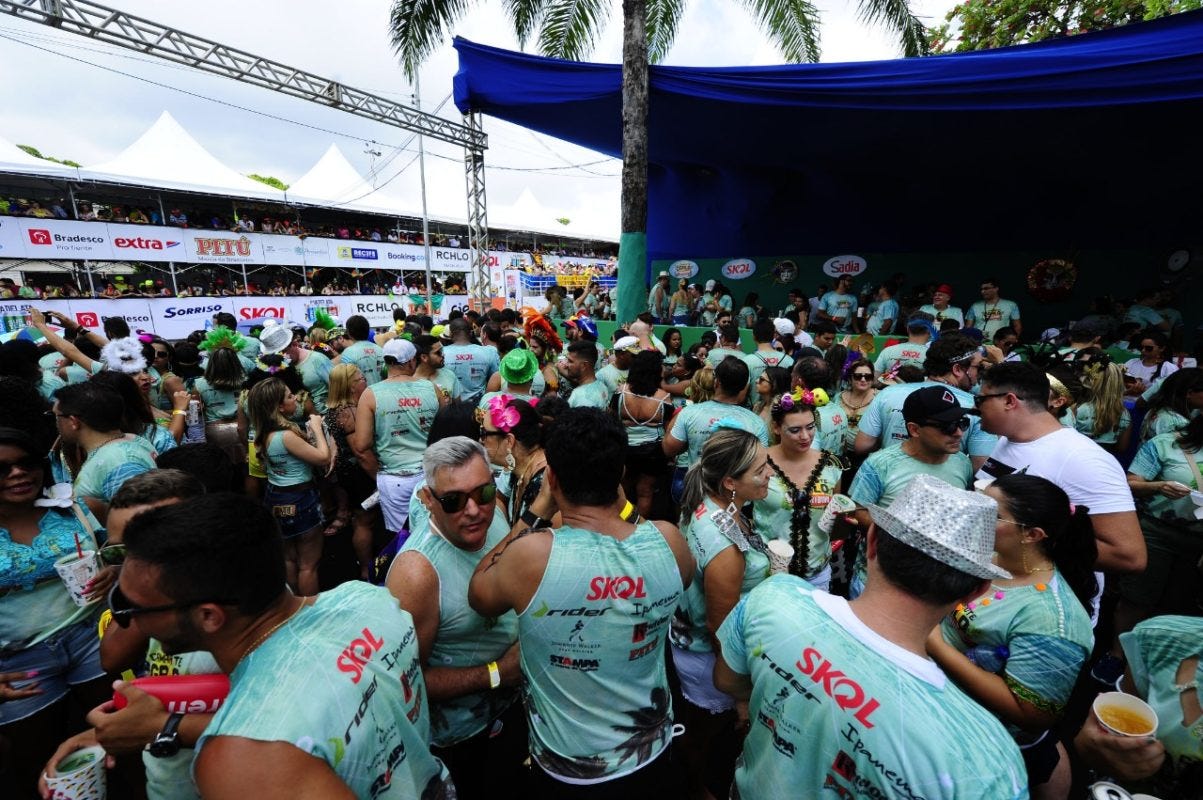

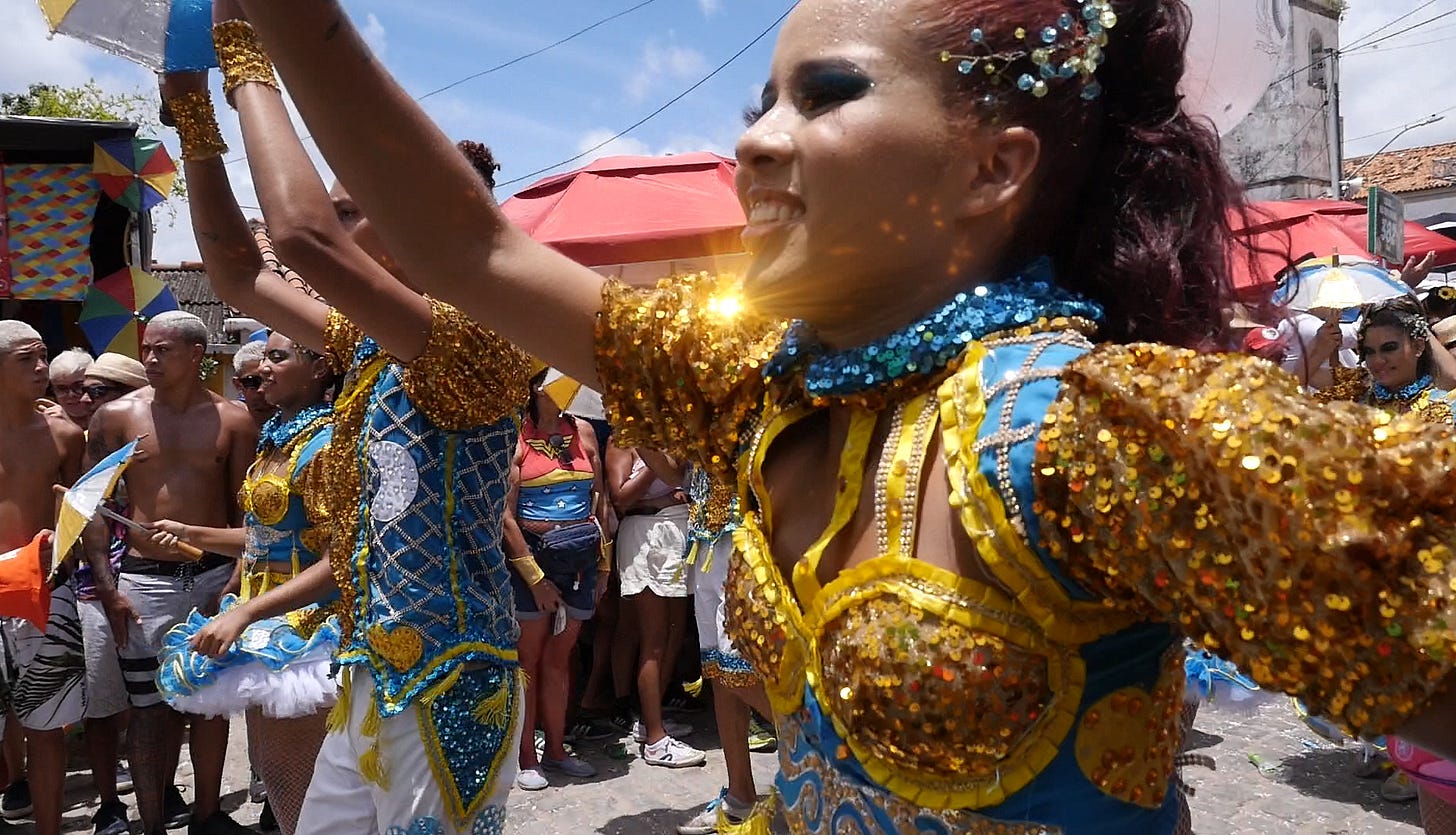
In Europe, from medieval times through to today, carnaval served the same class-critical purpose. (There's a great photo somewhere of a giant parade float chariot driven by magnified-scale papier-maché caricatures of Fiat executives in Roman senatorial togas whipping the costumed "slaves" who are pulling through the streets.) I sent your article on to my professor from the days of my medieval theater studies at U of Michigan. I'm sure he'll appreciate it as much as I do.